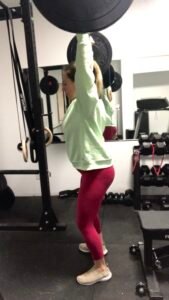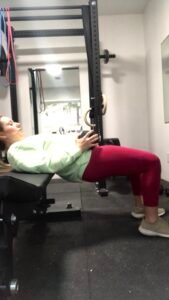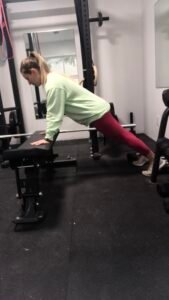Strength Training Exercise Modifications During Pregnancy
Pregnancy Strength Training Exercise Modifications
Strength training while pregnant is safe and offers lots of benefits to you and baby. Even if you are new to exercising, you can still safely begin strength training while pregnant. However, there are strength training exercise modifications you will need to make throughout pregnancy.
We know it’s important to adjust the exercise intensity of any exercise you are doing. I covered this in depth in the last article – The Complete Guide to Exercise During Pregnancy. In this article, we will cover activities to avoid, ways to modify exercise by symptoms, and strength training exercise modifications. If you are interested in how you can safely maintain or gain muscle mass and strength throughout pregnancy with strength training, then keep reading!
*Disclaimer – If you are a postpartum, pregnant or have any other health conditions, make sure you always seek the advice of your physician or other qualified health care provider. Content on this blog should not be considered a substitute for professional medical advice, expertise, or treatment.
Exercises to Avoid While Pregnant
Before we discuss strength exercise modifications you will need to make, we first need to cover which exercises and activities you should avoid during pregnancy.
You should stop exercises that cause doming in the abdomen and pressure or pain in the pelvis. This could indicate improper pressure management which could be addressed by changing intensity or modifying the exercise. If pain or pressure in pelvis persists you should bring up any concerns with your ob-gyn, midwife, or meet with a pelvic health physiotherapist.
Exercises or activities that have a risk of falling, for example skiing, gymnastics, surfing and horseback riding, should also be avoided during pregnancy. As well as any activities that could cause trauma to your belly, like martial arts, combat sports, and Olympic lifts where the bar path crosses the abdomen. Some highly skilled athletes may continue to do these lifts, but it is not recommended for general population.
There is evidence that doing exercise in hot climates or at high humidity, like hot yoga, could increase your core temperature too high and cause stress to the fetus or cause central nervous system developmental disorders. Therefore, it’s suggested that you avoid raising your core temperature above 102° F.[1][2]
Lastly, exercising at elevations above 6,000ft, unless already accustomed to, should also be avoided as well as scuba diving.[3]
Pregnancy Strength Training Exercise Modifications by Symptom
You may need to make exercise modifications based off symptoms you are experiencing. It’s important that you are exercising in ways that promote a healthy pregnancy and postpartum recovery. If you are dealing with pain or a worsening of symptoms while exercising, then you should make adjustments to the exercise. Below are common pregnancy symptoms and how exercise can be modified to help.
Fatigue
Fatigue is a common pregnancy symptom that may persist all throughout pregnancy. Exercise will help with fatigue, but could also make it worse if you’re overtraining. Ways you can help prevent pregnancy fatigue while exercising are by adding in a low intensity cardio warm-up or increasing your rest periods between sets. You could also try adding in active rest days to give you more energy. An active rest day could just be light walking or stretching. The goal is to stay consistent with exercise, this may mean you may have to reduce frequency, length, or intensity of your workouts to help get through pregnancy fatigue.
Shortness of Breath
Shortness of breath is normal and may start in your first trimester and continue as baby grows and starts taking up more space. You may need to move slower to catch your breath. You could also try lowering the intensity or increasing rest periods between sets.
Morning Sickness or Queasiness
Morning sickness is usually most prevalent in the first trimester, but for some it can linger throughout the entire pregnancy. Some may feel mild morning sickness that may strike at any time of day. If you are experiencing mild morning sickness, exercise may help alleviate your nausea.
One thing you could do to reduce morning sickness during exercise is to try training at different times of day. If you typically feel morning sickness first thing in the morning, you can opt for an evening session. If it gets worse by the evening, train first thing in the morning.
It may help you to change the types of exercises you are doing or the environment you are exercising in. If you’re sensitive to bright lights, loud noises, or humidity, then take that into consideration. If jumping or changing from lying to standing makes you queasier, then omit these things from your workout.
Finally, it may help you to eat a small snack before and after workout. Eat bland foods and experiment with which foods feel good to you when you’re working out.
Breast Tenderness
One of the first signs of pregnancy for many is sore breasts. There are some exercises you can exclude from your routine to avoid making this even more painful. Avoid jumping exercises and those that require you to put pressure on your chest, like the chest supported row, lying leg curl, or supermans. We will cover how to modify prone exercises below!
Pelvic Girdle Pain
Pelvic Girdle Pain can be felt in the pelvic joints, low back, hips, and even the upper thighs. Exercising may help prevent the occurrence of pelvic girdle pain later in pregnancy. If you are dealing with this during exercise, there are some tweaks you can make to help reduce this pain. First, it may be painful to do single leg or split stance exercises. Instead of a lunge, try squats. You may have to switch up your range of motion or stance. If a wider stance elicits pain, then try moving your feet inward.
You could also try not going as deep into a lunge or squat or even adding stability, like using a box to squat on or a TRX band to hold onto while squatting or lunging. When doing floor exercises keep legs together when going from side to side, or you could use a pilates ball between your thighs to help activate core and inner thigh muscles to add extra stability to the pelvic joints. Speaking of stability, just making sure you are engaging your core and using proper alignment while lifting can be enough to help relieve the pain.
Round Ligament Pain
Round ligament pain is common during the second trimester and may feel like a sharp or dull pain in the abdomen or groin. Luckily this should relieve itself in a few weeks, but there are some adjustments you can make to your exercises that may make the pain more manageable. Just like pelvic girdle pain, adding more stability to your workouts may help. Instead of standing, try sitting or using a wall or trx band for more support with standing exercises.
You could also add support to your abdomen, for example switching to a single arm shoulder press so you can use the other arm to rest and support the under belly. Slowly transition between exercises or when getting up from the ground to prevent stretching the ligament too quickly. You should also avoid any jumping or high impact exercises. Focus on proper alignment and contraction of the core and pelvic floor to offer the belly additional support.
Instability or Feeling Off Balance
As you experience a weight shift towards your anterior from your growing belly and breasts you may start to experience instability. This will make certain exercise more difficult, such as single leg movements. As you find these exercises more difficult and harder to balance, you can decrease the amount of weight you are lifting or decrease range of motion. You could also add extra support to the exercise, such as using a band when doing squats, lunges, or step ups. Exercises that used to seem easier in the beginning of your pregnancy will become harder because you are carrying an additional 20-30 pounds. So remember this when determining how much weight to lift.
Loose Joints
Another thing you may not notice, but should be aware of, is loose joints. During pregnancy your body starts producing the hormone relaxin. Relaxin is responsible for relaxing your ligaments to help open your pelvis for birth. This means joints become less stable and more susceptible to injury. You should avoid doing jerking movements and overstretching. For example, skip ballistic stretches and instead do dynamic stretches for a warmup.
Coning or Doming of Linea Alba
As our bellies grow, the linea alba stretches and thins to make room for baby. This becomes a weak spot that can be susceptible to rises of pressure in our core. If we don’t properly manage this pressure it will push through this tissue or down on our pelvic floor.
Pay close to attention to bulging, coning, or doming in your abdomen during exercise. It may also feel like a tugging or pulling sensation in your abdomen. If you have trouble seeing this, then you can place your hand over the midline of your belly and feel for your belly pushing out or flattening during an exercise. If you feel “pushing out” then this is a sign of improper pressure management. Luckily there are exercise modifications you can make to prevent this, help maintain core strength, and make sure you don’t further weaken the tissue during pregnancy.
How to Prevent Coning of Linea Alba
First, make sure you are breathing properly. You should not be holding your breath or using the Valsalva maneuver. This increases the amount of pressure in the abdomen and can further weaken the tissue. Adjust your breathing pattern by exhaling during the hard part of the exercise and inhaling on the easy part. Practice the Connection Breath to help you better connect your breath to your core and pelvic floor, especially during exercise.
Decrease the weight or the intensity of the exercise. If you have trouble not holding your breath to complete the exercise, you may be using too much weight. You should not be lifting above 85% 1RM or higher than an 8.5/10 exertion level.
When you notice an exercise still causing coning or doming even after lowering the weight, then you should either try to modify the exercise or choose a different exercise. For example, if you are doing a front plank on the floor, you could modify it by elevating the plank by placing your hands on a bench. If you still notice coning, try switching to a bird dog exercise where there will be less strain on your core.
If you can do the exercise, but notice coning appearing towards the end of the set, then maybe you aren’t leaving enough repetitions in the tank. Try lowering the number of repetitions or sets so you are not going until muscle failure.
To maintain or gain strength in your core include more core exercises in your prenatal routine. Diastasis recti is inevitable during pregnancy, but we can work to limit its negative effects on our core. Incorporate exercises that challenge the muscles of the deep core and pelvic floor to help improve or retain the core’s function throughout pregnancy.
Modifications for Strength Training Exercise During Pregnancy
We’ve covered how you can modify exercise based off pregnancy symptoms you may be experiencing. Now we will get into how to modify certain types of exercises and how you can adjust and continue the major lifts as your pregnancy progresses.
Prone Exercises
Prone exercises are movements that are performed while lying on your stomach. These will need to be modified as your belly grows. When to make this adjustment will depend on you and when they no longer feel they are comfortable for you. For many, this change occurs at the beginning of the second trimester.
Some examples of prone exercises are lying leg curl, supermans, and chest supported row. In this case it would be easier to modify prone exercises by choosing a different variation. For these examples, you could do a seated or standing leg curl instead of a lying leg curl. Instead of a superman on your belly you could move into a superman on hands and knees, also known as bird dog. There are many different variations of the row that you could perform that don’t require you to lie prone, these include standing cable row, bent over dumbbell row, and seated cable row.
Supine Exercises
Supine exercises are movements that are performed on your back. It has been advised that these exercises should be excluded completely starting second trimester. The reasoning is that when lying on the back for long periods of time the weight of the uterus and baby is pressing on the vena cava (large vein carrying blood back from the lower body to the heart) and causing lack of blood flow to you and baby. New research shows that supine exercises are safe if you aren’t experiencing symptoms, such as light-headedness nausea, tingling in legs, difficulty breathing.
Supine exercises are safe to do during a short duration of time, such as 30-60 seconds per exercise, but if you are more comfortable avoiding them then you can modify the exercise. For example, instead of a flat bench press, you can do an incline press. Other floor exercises you could try using a bosu ball, rolled up mat, or pad to elevate your head and shoulders.
Chest Press
The barbell chest press is safe to do all throughout pregnancy. To avoid any stretching or pressure placed on abdominal wall, place feet up on bench while pressing. Avoid arching back and continue to exhale while pressing bar up. If this isn’t comfortable for you, you can try elevating the bench and doing incline chest press. You can also switch to dumbbells or a standing chest press variation using a band or cable.
Pullup or Pulldowns (Vertical Pull)
Pullups or pulldowns have a higher chance of causing coning. Pullups may be ok for you to do in the first trimester, but it may be a good idea to switch these out once you start feeling a tugging or pulling sensation in your abdomen. You can switch to a cable or banded pulldown or a ring row. If you are having trouble not arching, try single arm pulldowns or lowering the weight.

Rows (Horizontal Pull)
The barbell row may become challenging as the belly grows and there’s increased strain on the lower back. To help avoid strain add more support. For the barbell row you could add blocks or perform them in a power rack with an elevated bar. This allows you to set the bar down after each repetition, which will reduce lower back strain and allow you more rest.


If you are using a dumbbell, you could also set the dumbbell down on a bench or box between repetitions or add more support and comfort by increasing the angle of the row by using an incline bench. Another variation you can do is a seated cable or band row while keeping a neutral spine.


Overhead Press
The overhead press also has a higher chance of coning because most people tend to lean back to press the weight. You may have to switch from barbell to dumbbells if you have trouble avoiding leaning back or keeping ribcage down, especially as the bar crosses over your head.

You could add more support by switching to a seated overhead press. If you still notice coning, try doing a single arm kneeling press with added lat activation by pulling a band down in the other hand (the banded pulldown is demonstrated above). This will help keep the ribcage down. You could also try adjusting the angle of the exercise by performing a landmine press.


Squat
The biggest thing you will want to modify with the squat is adding more support. If you were doing front squats before they might start to put more strain on the abdomen as your pregnancy progresses. You may be more comforting performing a back squat with a wider stance to make room for the belly. Squats may cause heaviness in the pelvic floor on the lowering portion. Around the second to third trimester, you can shift to box squats to add more support. When using a box or bench, you want to make sure you are tapping down instead of sitting to ensure you are maintaining a neutral spine position. It might be beneficial to include dumbbell or bodyweight squats in your third trimester as you may need to lower intensity.


Deadlift
The deadlift is a great exercise to do your entire pregnancy. If you were doing conventional deadlifts, around the second trimester you may want to shift to sumo stance deadlifts to make room for your belly. You can also elevate the bar using plates, boxes, or doing them in the power rack or smith machine. This will help you not hinge as much and help you stay in a neutral spine position.


Hip Thrust
Many think they cannot barbell hip thrust as soon as they get pregnant because it will hurt the baby. If modified, you can safely hip thrust as long as it is comfortable for you. This is beneficial because it allows you to load much more weight compared to using just a band or dumbbell. There are adjustments you will need to make.
First you will want to elevate the bar to reduce range of motion. You can do this by using plates, boxes, or my personal favorite – a smith machine. Once you can easily get in and out of an elevated bar, you can lower the bar placement right under your bump to upper thighs. Then you want to make sure you are pivoting from your upper back rather than your sternum to reduce stretching of the abdomen.


Another trick is to use two fat grips under your hip thrust pad to make more space in between for your bump. If you are uncomfortable using a barbell, then you can do them banded or with a dumbbell. You can switch to kneeling banded hip thrust if being horizontal is too uncomfortable later in pregnancy.
Core Exercises
Core training is important to keep doing all throughout pregnancy, but you should avoid any core exercises that cause coning. These will be any exercise that causes extra pressure in the abdomen like front planks or hanging leg raises. If front planks cause coning or doming, try elevating the plank by moving your hands or elbows onto a bench.

Flexion exercises, like crunches, will become difficult as well as your belly grows, and you may want to omit them. There are lots of core exercises you can do safely. Add more stability to your core and perform more anti-movement (resist movement) exercises, like the pallof press, which can be done standing or kneeling.
Pregnancy Strength Training Exercise Modifications Conclusion
Exercising during pregnancy can come with some challenges due to pregnancy symptoms and your body constantly changing. There are some exercises or activities you should completely avoid. However, many exercises that you have already been doing are most likely safe to continue. The strength training exercises you have been doing you may need to make modifications to during pregnancy.
While strength training while pregnant, you should always keep in mind how the exercise is making you feel. Always make sure you are in proper alignment and that you are breathing properly to help manage intra-abdominal pressure. It’s good to know the signs to stop or caution exercise as well as what the right intensity you should be working at to keep you and baby safe during exercise.
If you would like to learn more about how to safely exercise during pregnancy while still making strength training gains, check out the Complete Guide to Exercise During Pregnancy!
Similar Posts:
- A Complete Guide to Safe and Effective Exercise During Pregnancy
- Must-Do Core Exercise for Pregnancy and Postpartum: Connection Breath
- How to Make Time to Exercise as a New Mom [And Make it a Routine!]
Share with your pregnant mamas so they can confidently strength train during their pregnancy by making these exercise modifications!

References:
- Ravanelli, N., Casasola, W., English, T., Edwards, K. M., & Jay, O. (2019). Heat stress and fetal risk. Environmental limits for exercise and passive heat stress during pregnancy: a systematic review with best evidence synthesis.British journal of sports medicine, 53(13), 799–805. https://doi.org/10.1136/bjsports-2017-097914
- Patterman, A., Porcari, J. P., Schwab, E., Doberstein, S., Jaime, S., Foster, C., & Green, D. J. (2020, December). Research special issue – the safety of Hot yoga for pregnant women. ACE. Retrieved April 3, 2023, from https://www.acefitness.org/continuing-education/certified/researchspecialissue/7798/the-safety-of-hot-yoga-for-pregnant-women/
- Physical activity and exercise during pregnancy and the postpartum period. ACOG Committee Opinion No. 804. American College of Obstetricians and Gynecologists. Obstet Gynecol 2020;135:e178–88. https://www.acog.org/clinical/clinical-guidance/committee-opinion/articles/2020/04/physical-activity-and-exercise-during-pregnancy-and-the-postpartum-period


2 Comments
Comments are closed.